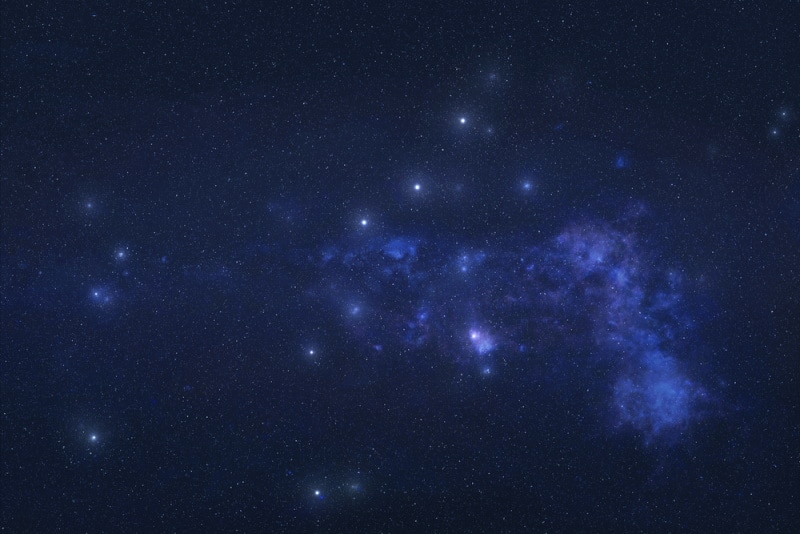8 Interesting Perseus Constellation Facts, Myths & FAQs
Last Updated on

For thousands of years, civilization has looked up into the night sky to tell tales of mythological creatures that make up what we know as constellations. Among them, the Perseus constellation has its own story, as well as other scientific wonders that we’ll talk about in just a moment.
Keep reading because we’re going to lay out eight interesting facts, myths, and questions you may have about the Perseus constellation!

Top 8 Facts & Myths About the Perseus Constellation
1. Its Brightest Star Is Mirfak (Alpha Persei)
The brightest star that lies within Perseus is Mirfak, a supergiant that is roughly 600 light-years away from our planet. If Mirfak were to be replaced with our Sun, it would be much more luminous because of its size. Finding this star in the night sky is relatively easy, so long as you’re in the northern hemisphere. It’s in between Polaris (the North Star) and the Pleiades star cluster, but it’s recommended that you look for Cassiopeia, a nearby constellation with a W-shape.

2. Perseus Has a Double Galaxy
The first notable object is NGC 1275, which is a ‘dual’ galaxy that spans 100,000 light years in length. In fact, scientists suggest that NGC 1275 is a mix of a type-CD galaxy and an HVS galaxy. It’s elliptical, which means that it doesn’t have a circular motion, unlike spiral galaxies. Some predictions suggest that a supermassive black hole is at the center of the galaxy. Luckily, this space wonder is over 200 million light-years away, so we won’t have to worry about it bothering Earth!
3. Messier 34 Star Cluster
Deep within Perseus is Messier 34, or M34 for short. Estimates on the age of the Messier 35-star cluster show that it could be over 200 million years old, but the real kicker is that it holds 400 stars that are all bundled up in the night sky. With an apparent magnitude of 5.5, it’s not the brightest thing in the Hero constellation, but its diameter reaches a length of nearly 14 light-years across!

4. More About Perseus in Mythology
Other than the story that we mentioned earlier, there’s a lot more to be said about Perseus’s backstory. Incredibly enough, the hero was indeed the son of Zeus, the god of all gods and people. He’s also the son of Danae, but she and Perseus were cast away to sea in a box when he was a baby. Later, he made many remarkable journeys to help others, such as princess Andromeda. So, when you look for the Andromeda galaxy while stargazing, you won’t be far off from Perseus!
5. Meteor Showers
One specialty of Perseus is the Perseids, an annual phenomenon of meteor showers that pass through the constellation for months at a time. These occurrences have been on record for thousands of years, with their highest density of meteors coming in during the month of August. However, they start in the middle of July and continue on in September. During the early fall, the September Epsilon Perseids take place and pass through the Oort Cloud.

6. Algol Is Its Most Famous Star
Although Mirfak is the brightest star in Perseus, it isn’t as well-known as Algol, or Beta Persei, the second-brightest star in the constellation. Algol was the first ever star observed that falls under the binary eclipsing category. This means that there is another star that moves in front of it so that it can’t be viewed. This is quite similar to a solar eclipse, where our Moon swings in front of the Sun. Check the Algol eclipse calendar to try and see it for yourself!
Frequently Asked Questions (FAQs)
7. What Is the Story of Perseus?
This notable constellation was named after what might be the most famous hero in Greek mythology: Perseus. As the story goes, Perseus was sent by King Polydectes to retrieve Medusa’s head. This wasn’t an easy task, though. The tale explains that Medusa’s glare can kill any person instantly by turning them to stone. Tosolve this, Perseus slayed Medusa in her sleep because her eyes were closed. When he retrieved the head of Medusa, he instead used the head to turn King Polydectes into stone and gave the throne a new leader.

8. How Many Stars Are in the Perseus Constellation?
In the Perseus constellation, there are around 19 main stars. However, the most notable and named stars would only total about eight, which are called Miram, Algol, Atik, Misam, Muspelheim, Mirfak, Misam, and Berehinya. All eight of these stars are recognized by the International Astronomical Union (IAU). Furthermore, there are seven stars in this constellation that have planets in orbit, and 59 are part of the Bayer or Flamsteed designations.

Final Thoughts
Within the borders of the Perseus constellation, there are a few fascinating areas that can be seen with the help of a high-power telescope or even the naked eye. Galaxies, star clusters, meteors, and many other space wonders can be witnessed at its core. We hope you enjoyed our eight interesting facts about the Perseus constellation!
Featured Image Credit: Pike-28, Shutterstock
About the Author Robert Sparks
Robert’s obsession with all things optical started early in life, when his optician father would bring home prototypes for Robert to play with. Nowadays, Robert is dedicated to helping others find the right optics for their needs. His hobbies include astronomy, astrophysics, and model building. Originally from Newark, NJ, he resides in Santa Fe, New Mexico, where the nighttime skies are filled with glittering stars.
Related Articles:
15 Crucial Facts About Ultraviolet Rays & the Sun
What Constellation Is Spica In? The Interesting Answer!
10 Interesting Leo Constellation Facts, Myths, and FAQs
15 Interesting Pegasus Constellation Facts, Myths, and FAQs
6 Interesting Sagittarius Constellation Facts, Myths, and FAQs in 2024!
What Are Constellations? Where Did They Come From?
8 Interesting Libra Constellation Facts, Myths, and FAQs
What Is Infrared Radiation? Science-Based Facts & FAQ
